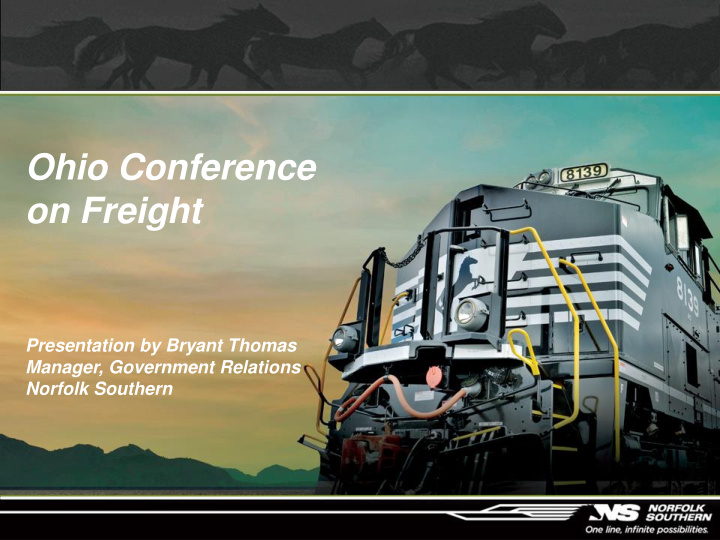



Ohio Conference on Freight Presentation by Bryant Thomas Manager, Government Relations Norfolk Southern
Ohio is a crossroads of U.S. Freight Railroads Almost 5,000 route miles covering Ohio Over 7,500 highly skilled and well-paid employees Four Class I railroads (CSX, NS, CP and CN) 33 Short Line / Regional railroads, representing almost 40% of route miles in Ohio Sources: AAR 2013 Railroad Facts Booklet ASLRRA 2014 Short Line and Regional Railroad Facts and Figures Booklet
Railroad Safety Regulation Railroad Safety and Operations are regulated under the Federal Railroad Authority - 49 CFR Chapter II These laws provide the FRA with very broad authority over “every area of railroad safety.” The FRA has issued a wide range of safety regulations such as: Track, equipment, locomotives, freight cars, maintenance of active warning devices at highway-rail grade crossings, operating rules and practices, positive train control, and use of train horns at grade crossings. Common carrier transportation, service, and rates - 49 U.S. Code § 11101 - A rail carrier providing transportation…shall provide the transportation or service on reasonable request
Safety Investment Means Results Freight railroads spent more than $660 billion of private funds capital expenditures and maintenance expenses since 1980 Derailment rates, which declined 10% in 2016 from 2015, as well as track- caused accident rates, are also both all-time lows. The 2016 rail safety statistics continue a string of record-setting years, showing this period has been the safest ever for the rail sector. According to March 2017 FRA data based on per million train miles, since 2000 the: Train accident rate is down 44% Equipment-caused accident rate is down 34% Track-caused accident rate is down 53% Derailment rate is down 44%
Positive Train Control PTC is an unprecedented, advanced set of technologies that will automatically stop a train before certain human error incidents occur. Under the Rail Safety Improvement Act of 2008 (RSIA), passenger railroads and Class I freight railroads must install PTC on main lines used to transport passengers or toxic-by-inhalation (TIH) materials. Railroads expect to spend more than $10 billion
People and Cars in Ohio (Automobile Accidents) Ohio in 1990 Ohio in 2017 10.86 million residents 11.61 million residents – 6.9% change 10.6 million vehicles 6.7 million vehicles – 58.2% change Collisions: 5,715 Collisions: 2,105 Fatalities: 698 Fatalities: 274 Injuries: 2,407 Injuries: 807
Safety Investment at Crossings The installation of warning devices such as flashing lights and roadway gates is one way safety can be improved at rail crossings. Over the past 15 years, the PUCO has approved 3,300 safety upgrades at crossings throughout the state, with 102 upgrades approved in 2017 Federal and state funding resources are available to local communities to implement safety upgrades and install lights and gates at grade crossings. Federal Funding - Crossings for these upgrades are chosen based on a priority list that ranks the crossings in order of risk of accident. State Funding - For crossings not eligible for federal funding, the state-funded Grade Crossing Upgrade Program allows local communities to share the cost of installing safety devices with the state and the local railroad.
Grade Crossing Safety Statistics The PUCO’s staff of federally certified inspectors conducted 593 FRA railroad inspections in 2017. All 5,800 public grade crossings in Ohio were inspected for safety. There is still much work to be done to educate motorists on how to safely travel across railroad crossings. 82 percent of the crashes in 2017 occurred at crossings with active warning devices, up from 75 percent in 2016 The number of train-vehicle crashes at Ohio public highway-rail grade crossings has decreased significantly, from 123 in 2001 to 64 in 2016 to 68 in 2017
Blocked Crossings Concerns Rail Traffic is at all time highs U.S. rail traffic for all of 2017 rose 3.4 percent carloads and intermodal units compared with traffic in 2016 Total U.S. carload traffic for the first six months of 2018 up 1.3 percent from the same period last year; and intermodal units, up 6.0 percent from last year. Total combined U.S. traffic saw an increase of 3.7 percent compared to last year Also seeing record train lengths across the industry
Operational Regulation – Local Concerns Though most of railroad operations are federally regulated and thus preempt state and local laws – Local concerns still linger Local Issues: Train Horn Use/ Quiet Zone - 49 CFR Part 222 Blocked Crossing Regulation Idling Locomotives Operational Nuisances – Noise Pollution (Idling/Coupling), Light Pollution Proposed State Legislation 2017/2018 Two Person Crew Regulation Railyard Lighting Regulation Railyard Walkway Regulation Increase in Truck Size and Weight
INDOT Local Trax – Proactive Approach INDOT has made available at least $125 million for high-priority railroad safety projects on local roads statewide through the agency’s new “Local Trax ” matching grant program. The Local TRAX rail overpass program will provide grants to cities, towns and counties bodies for grade separation, crossing closure and other safety enhancement projects at rail-highway intersections on local roads. Represents a partnership with INDOT, local communities, businesses, industry and railroads Local Trax requires local governments to provide only 20 percent of funding for land acquisition and construction with the state providing the other 80 percent. Crossing closure component to awarded grants
Thank You
Recommend
More recommend